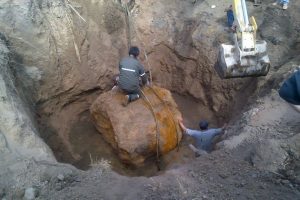
Credit: Ministerio de Gobierno/Facebook
The second-largest meteorite ever found has been exhumed outside the small Argentinian town of Gancedo.
The 30-tonne rock, named after the town, was discovered on September 10 and dug up by an excavation team which was shocked by its massive size.
“While we hoped for weights above what had been registered, we did not expect it to exceed 30 tonnes,” Astronomy Association of Chaco president Mario Vesconi said.
It is believed to have crashed to earth about 4,000 years ago as part of an iron meteorite shower covering hundreds of square kilometres, 1,000km north-west of Buenos Aires at a site now known as Campo del Cielo.
The original asteroid is estimated to have weighed about 600 tonnes and entered Earth’s atmosphere at 14,000 kilometres per hour, where it broke up into a shower of smaller meteorites, according to Scientific American.
Many of the smaller meteorites have been stolen from Campo del Cielo by tourists collecting souvenirs and meteorite traffickers.
Scientists say Gancedo will be reweighed to get an exact measurement.
The largest meteorite ever discovered, called Hoba, crash-landed in Namibia about 80,000 years ago and weighed 66 tonnes.
Hoba was discovered in 1920 by a farmer ploughing his field with an ox.
It remains in place as it was too large to relocate.







